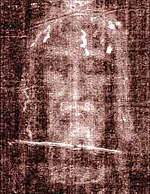Portal:Christianity/Selected article/17
The Shroud of Turin (or Turin Shroud) is an ancient linen cloth bearing the image of a man who appears to have been physically traumatized in a manner consistent with crucifixion. The image can not be seen on the shroud with the naked eye and for several centuries the shroud had been displayed without it. The image was first observed in 1898 on the reverse photographic plate when amateur photographer Secondo Pia was allowed to photograph it.
The shroud is presently kept in the royal chapel of the Cathedral of Saint John the Baptist in Turin, Italy. The Roman Catholic Church has approved this image in association with the devotion to the Holy Face of Jesus. Some believe it is the cloth that covered Jesus when he was placed in his tomb and that his image was somehow recorded as a photographic negative on its fibers, at or near the time of his proclaimed resurrection. Skeptics contend the shroud is a medieval hoax or forgery — or even a devotional work of artistic verisimilitude. It is the subject of intense debate among some scientists, believers, historians and writers, regarding where, when and how the shroud and its images were created.
Arguments and evidence cited for the shroud's being something other than a medieval forgery include textile and material analysis pointing to a 1st-century origin; the unusual properties of the image itself which some claim could not have been produced by any image forming technique known before the 19th century; objective indications that the 1988 radiocarbon dating was invalid due to improper testing technique; a 2005 study proving that the sample used in the 1988 radiocarbon dating came from a medieval patch and not the original Shroud; and repeated peer-reviewed analyses of the image mode which contradict McCrone's assertions. Also, pollen from many places the shroud was said to have gone through are found, such as pollen from plants that exist only in certain areas near Jerusalem.

